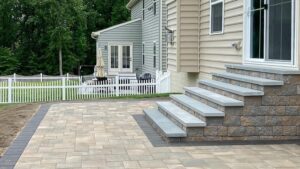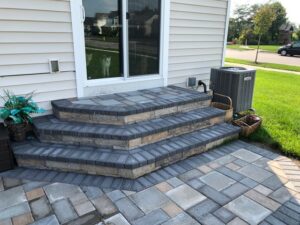Creating Eye-Catching Paver Steps Against a House
12 Eye Catching Paver Steps Against House?Paver steps can significantly enhance the aesthetic appeal and functionality of your home’s exterior.
Whether leading up to your front door, around a garden, or down to a patio, well-designed paver steps can create a stunning first impression. Here’s a comprehensive guide to help you design and implement eye-catching paver steps against your house.
1. Choosing the Right Pavers
The first step in creating attractive paver steps is selecting the right materials. Pavers come in various materials, including concrete, brick, stone, and composite. Each material offers distinct advantages:
Concrete Pavers: Durable, versatile, and available in numerous shapes, sizes, and colors. They can mimic the appearance of natural stone or brick.
Brick Pavers: Classic and timeless, they offer a warm and traditional look.
Stone Pavers: Natural stone such as limestone, granite, or slate provides a luxurious and organic feel.
Composite Pavers: Made from recycled materials, they are eco-friendly and come in various designs.
Consider the style of your home and the look you want to achieve when choosing pavers. For a cohesive appearance, match or complement the colors and textures with your house’s exterio.

12 Eye Catching Paver Steps Against House?
2. Designing the Layout
The design of your paver steps should blend seamlessly with the overall landscape and architecture of your home. Consider the following design elements:
Step Size and Shape: Ensure the steps are comfortable and safe. Standard step dimensions are 6-7 inches in height (riser) and 10-12 inches in depth (tread). Curved steps can add a graceful touch, while straight steps offer a clean, modern look.
Pattern and Layout: The pattern in which pavers are laid can significantly impact the overall aesthetic. Popular patterns include herringbone, basket weave, running bond, and stack bond.
Combining different patterns or creating a unique design can make the steps stand out.
Landing Areas: Incorporate landing areas at the top and bottom of the steps for safety and to enhance the visual appeal. These can be larger paver areas or a different material to create contrast.
3. Preparation and Base Construction
Proper preparation is crucial for the durability and appearance of paver steps. Follow these steps for a solid foundation:
Excavation: Dig out the area where the steps will be installed, ensuring it is deep enough to accommodate the base material, sand layer, and pavers.
Base Material: Lay a base of crushed stone or gravel, typically 4-6 inches deep, compacting it thoroughly to prevent shifting and settling.
Edge Restraints: Install edge restraints to keep the pavers in place and maintain the integrity of the design.
Sand Layer: Spread a 1-inch layer of coarse sand over the base material, leveling it smoothly.
4. Laying the Pavers
Once the base is prepared, it’s time to lay the pavers:
Start at the Bottom: Begin laying pavers from the bottom step, working your way up. This ensures each step is supported by the one below.
Cutting Pavers: Use a masonry saw or paver cutter to trim pavers for a precise fit, especially around curves or edges.
Check Alignment: Regularly check the alignment and level of the pavers to ensure a uniform and professional finish.
Fill Joints: After all pavers are in place, spread fine sand or polymeric sand over the surface and sweep it into the joints. This locks the pavers together and prevents weed growth.
5. Incorporating Lighting
Adding lighting to your paver steps not only enhances safety but also creates a dramatic effect, highlighting the steps and surrounding landscape:
Step Lights: Install low-voltage LED lights on the risers or under the treads for subtle, indirect lighting.
Path Lights: Place path lights along the edges of the steps or adjacent pathways to guide visitors and illuminate the area.
Solar Lights: Consider solar-powered lights for an eco-friendly option that requires no wiring.
6. Adding Landscaping Elements
Integrating landscaping elements around your paver steps can enhance the overall aesthetic:
Plants and Flowers: Plant low-maintenance perennials, shrubs, or ornamental grasses along the sides of the steps. Use planters or flower beds to add colour and texture.
Mulch and Ground Cover: Use mulch, decorative stones, or ground cover plants to fill gaps and create a cohesive look.
Water Features: Incorporate a small fountain or pond near the steps for a soothing and luxurious touch.
7. Maintaining Your Paver Steps
Proper maintenance ensures your paver steps remain attractive and functional for years:
Regular Cleaning: Sweep the steps regularly to remove dirt and debris. Use a pressure washer for a deeper clean.
Weed Control: Apply weed preventer to keep the joints free from unwanted growth.
Sealant Application: Consider applying a sealant to protect the pavers from stains, weathering, and UV damage. Reapply as needed, typically every 2-3 years.
Repairs: Promptly address any issues such as loose or cracked pavers to prevent further damage.

8. Creating a Focal Point
Make your paver steps a focal point by adding unique features:
Decorative Inserts: Incorporate decorative tiles, stones, or mosaic designs within the steps for a personalised touch.
Handrails: Install stylish handrails for safety and added visual interest. Choose materials that complement your pavers and house exterior.
Artwork and Sculptures: Place garden art, sculptures, or decorative pots around the steps to draw attention and create a welcoming entrance.
9. Colour and Texture Choices
Play with colours and textures to create a captivating look:
Contrasting Colours: Use contrasting colours for the risers and treads to make the steps stand out.
Textured Pavers: Choose pavers with different textures to add depth and interest. Smooth pavers combined with rough or embossed ones can create a dynamic look.
10. Integrating Different Materials
Combining different materials can enhance the visual appeal:
Wood and Stone: Integrate wooden steps or accents with stone pavers for a rustic yet sophisticated look.
Metal and Concrete: Use metal edges or inserts with concrete pavers for an industrial, contemporary style.
11. Seasonal Decor
Enhance your paver steps with seasonal decorations:
Spring and Summer: Add colourful pots with seasonal flowers, hanging baskets, or decorative flags.
Fall: Use pumpkins, gourds, and autumnal wreaths to create a cosy, inviting entrance.
Winter: Decorate with lights, evergreen garlands, and holiday-themed ornaments.
12. Safety Considerations
Ensure your paver steps are safe for all users:
Non-Slip Surfaces: Choose pavers with a textured, non-slip surface to prevent accidents, especially in wet or icy conditions.
Handrails: Install sturdy handrails on both sides of the steps for added support.
Adequate Lighting: Ensure the steps are well-lit, particularly at night, to prevent trips and falls.
Final Result
Eye-catching paver steps can transform the exterior of your home, adding both beauty and functionality. By carefully selecting materials, designing thoughtfully, and incorporating lighting and landscaping elements, you can create a stunning entrance that enhances your home’s curb appeal. Regular maintenance and seasonal updates will keep your paver steps looking their best for years to come.
Read Also.Garbage Disposal Not Working? Here’s What to Do